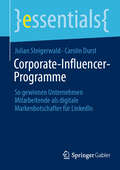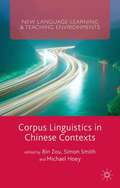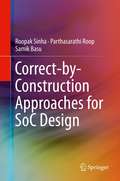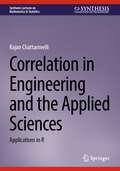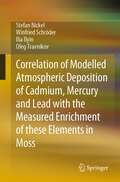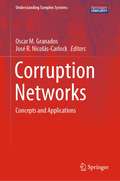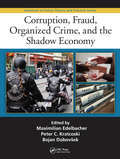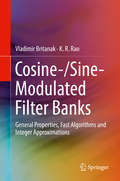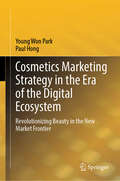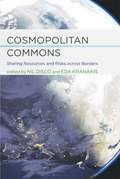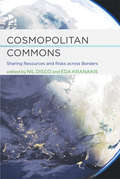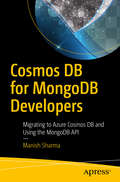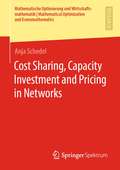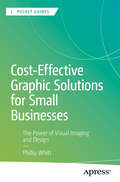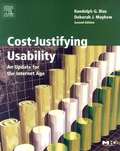- Table View
- List View
Corporate Risk Management: A Case Study on Risk Evaluation (Springer Texts in Business and Economics)
by Joachim Häcker Dietmar ErnstIn times of crisis, risk management is more important than ever. In addition, companies are obliged to identify, quantify and aggregate risks as part of a risk management system. Legal and auditing standards have set the framework for doing so. This book uses a case study to show ‘step by step’ how risks can be analyzed and quantified with the help of Microsoft Excel. The book begins with the graphical representation of risks and the calculation of risk parameters such as the value at risk. It subsequently aggregates different risks into an overall risk using Monte Carlo simulation. Hedging risks is also explained, and how non-hedgeable risks can be integrated into a business plan. The assessment of extreme risks is also addressed, as is the modeling of volatilities. The book is aimed at students of business administration with a focus on finance.
Corporate Security in the Asia-Pacific Region: Crisis, Crime, Fraud, and Misconduct
by Christopher J. Cubbage CPP David J. Brooks PhDAs corporations and governments become more litigious and risk averse, international risk management becomes more complex. Corporate Security in the Asia-Pacific Region: Crisis, Crime, Fraud, and Misconduct examines real cases of corporate crisis, crime, fraud, and other misconduct that corporate security professionals need to be aware of to effect
Corporate Semantic Web: Wie semantische Anwendungen in Unternehmen Nutzen stiften (X.media.press)
by Börteçin Ege Bernhard Humm Anatol ReiboldCorporate Semantic Web - hierbei geht es um semantische Anwendungen, deren Einsatz für Kunden und Mitarbeiter von Unternehmen konkret Nutzen stiftet. Die Autoren, namhafte Experten aus Industrie und Wissenschaft, berichten über ihre Erfahrungen bei der Entwicklung solcher Anwendungen. Sie gehen auf Software-Architektur, Methodik, Linked Open Data Sets, Lizenzfragen und Technologieauswahl ein und präsentieren auch eine Marktstudie. Vorgestellt werden Anwendungen für die Branchen Telekommunikation, Logistik, verarbeitende Industrie, Energie, Medizin, Tourismus, Bibliotheks- und Verlagswesen sowie Kultur. Der Leser erhält so einen umfassenden Überblick über die Einsatzbereiche des Semantic Web sowie konkrete Umsetzungshinweise für eigene Vorhaben.
Corporate-Influencer-Programme: So gewinnen Unternehmen Mitarbeitende als digitale Markenbotschafter für LinkedIn (essentials)
by Carolin Durst Julian SteigerwaldDieses essential bietet eine fundierte Analyse und praktische Hinweise zur erfolgreichen Implementierung von Corporate-Influencer-Programmen auf LinkedIn. Es beleuchtet die entscheidenden Einflussfaktoren, die Mitarbeitende motivieren, als digitale Markenbotschafter für ihr Unternehmen zu agieren und zeigt auf, wie Unternehmen diese Potenziale optimal nutzen können. In einer detaillierten Conjoint-Analyse werden die Rahmenbedingungen für erfolgreiche Programme untersucht – von besonderer Bedeutung ist dabei eine moderne und gelebte Unternehmenskultur. Für alle Verantwortlichen in der Unternehmenskommunikation, HR und Marketing, die ihre Strategien im Bereich Corporate Influencing optimieren und langfristig eine positive Arbeitgebermarke aufbauen wollen.
Corpus Linguistics in Chinese Contexts (New Language Learning and Teaching Environments)
by Simon Smith Bin Zou Michael HoeyRapid advances in computing have enabled the integration of corpora into language teaching and learning, yet in China corpus methods have not yet been widely adopted. Corpus Linguistics in Chinese Contexts aims to advance the state of the art in the use of corpora in applied linguistics and contribute to the expertise in corpus use in China.
Correct Software in Web Applications and Web Services (Texts & Monographs in Symbolic Computation)
by Klaus-Dieter Schewe Bernhard Thalheim Andreas Prinz Bruno BuchbergerThe papers in this volume aim at obtaining a common understanding of the challenging research questions in web applications comprising web information systems, web services, and web interoperability; obtaining a common understanding of verification needs in web applications; achieving a common understanding of the available rigorous approaches to system development, and the cases in which they have succeeded; identifying how rigorous software engineering methods can be exploited to develop suitable web applications; and at developing a European-scale research agenda combining theory, methods and tools that would lead to suitable web applications with the potential to implement systems for computation in the public domain.
Correct-by-Construction System on Chip Design
by Parthasarathi Roop Samik Basu Roopak SinhaThis book describes an approach for designing Systems-on-Chip such that the system meets precise mathematical requirements. The methodologies presented enable embedded systems designers to reuse intellectual property (IP) blocks from existing designs in an efficient, reliable manner, automatically generating correct SoCs from multiple, possibly mismatching, components.
Correction Formulae for the Stress Distribution in Round Tensile Specimens at Neck Presence (SpringerBriefs in Applied Sciences and Technology)
by Andreas Öchsner Magdalena Gromada Gennady MishurisThe monograph deals with methods to determine mechanical properties and evaluate the flow curve of ductile materials from the tensile test. It presents classical hypotheses concerning the onset of neck creation as well as the state of the art in determining the mechanical properties from the tensile test, with emphasis on the consequences of the neck formation. It revises derivations of formulae for the stress distribution in the minimal cross-section of the axisymmetrical specimen in the classical approaches proposed by Bridgman, Davidenkov / Spiridonova and Siebel as well as in the less famous formulae derived by Szczepinski and Malinin / Petrosjan. The revision is completed with solutions evaluated by the authors. In the monograph, the simplifying assumptions utilised in the classical approaches were carefully verified by numerical simulations accompanied by theoretical analysis. Errors imposed in the evaluation of the average axial stress acting on the minimal cross-section as a result of every particular simplification are estimated. The accuracy of all formulae to evaluate the flow curve is discussed. The significance of a high accurate determination can be seen in the context of numerical simulation (e.g. finite element computations), where the total error and accuracy is partly based on the accuracy of the material input.
Correlation in Engineering and the Applied Sciences: Applications in R (Synthesis Lectures on Mathematics & Statistics)
by Rajan ChattamvelliThis book focuses on correlation coefficients and its applications in applied science fields. The book begins by describing the historical development and various types of correlations. Rank correlation methods including Pearson’s, Spearman’s, and Kendall’s correlation are discussed at length. The book also discusses sampling distribution of correlation coefficients and applications of correlations in various fields. The book presents novel topics such as (i) a quick analytical method to approximate Pearson's correlation, (ii) single-variable correlation, (iii) fractional co-skewness and co-kurtosis, and (iv) the fallacy on correlation between the sample mean and sample variance. This book is ideal for courses on mathematical statistics, engineering statistics, and exploratory data analysis and is primarily aimed at upper-undergraduate and graduate level students. The book is also useful for researchers and professionals in various fields who are interested in data analysis.
Correlation of Modelled Atmospheric Deposition of Cadmium, Mercury and Lead with the Measured Enrichment of these Elements in Moss
by Winfried Schröder Stefan Nickel Ilia Ilyin Oleg TravnikovThe book provides a unique analysis of current air pollution in Germany by correlating results from chemical transport modelling and accumulation monitoring by moss.Results of most recent modelling of atmospheric concentration and deposition of the metal elements Cd, Hg and Pb are compared with the results of technical measurements and bioindication with mosses. These modelling results with status 2020 have a higher spatial resolution of 0.1° x 0.1° than the modelling results valid up to then (50 km x 50 km). This leads to partly slightly higher correlations between the findings of the modelling and those of the moss monitoring. In this study, descriptive and correlation-statistical parameters are calculated, results and recommendations drawn described. A statistically adequately deepened analysis and evaluation of the highresolution modelling results requires additional methodological tools, which are outlined in summary. It is particularly important to link the exposure data from modelling, technical measurements and the findings from moss monitoring with information on the receptors, the ecosystem types. This is the only way to ensure that the results of the present project contribute to a more differentiated assessment of the impacts on ecosystems from atmospheric heavy metal deposition than has been the case to date, thus enabling a targeted further development of risk assessments for German
Corruption Networks: Concepts and Applications (Understanding Complex Systems)
by Oscar M. Granados José R. Nicolás-CarlockThis book aims to gather the insight of leading experts on corruption and anti-corruption studies working at the scientific frontier of this phenomenon using the multidisciplinary tools of data and network science, in order to present current theoretical, empirical, and operational efforts being performed in order to curb this problem. The research results strengthen the importance of evidence-based approaches in the fight against corruption in all its forms, and foster the discussion about the best ways to convert the obtained knowledge into public policy.The contributed chapters provide comprehensive and multidisciplinary approaches to handle the non-trivial structural and dynamical aspects that characterize the modern social, economic, political and technological systems where corruption takes place.This book will serve a broad multi-disciplinary audience from natural to social scientists, applied mathematicians, including law and policymakers.
Corruption, Fraud, Organized Crime, and the Shadow Economy (Advances in Police Theory and Practice)
by Peter C. Kratcoski Maximilian Edelbacher Bojan DobovšekFueled by corruption, fraud, and organized crime, the shadow economy also known as the informal, black market, illegal, or underground economy is currently on the rise worldwide. Corruption, Fraud, Organized Crime, and the Shadow Economy addresses shadow economies and the players involved by examining various aspects of criminal law and prosecution
Coseismic Landslides: Intelligent Prediction and Recognition
by Lizhe Wang Xuewen Wang Xianmin Wang Haixiang Guo Qiyuan Yang Aomei ZhangFocusing on Habitable Earth for sustainability, this book develops novel and sophisticated deep learning algorithms and explores their successful application in intelligent prediction and recognition of coseismic landslides. These algorithms have originality and unique advantages in relatively high accuracy, low false alarms, strong generalization, and good interpretability. They were successfully applied in a series of violent earthquakes occurring worldwide from 2008 to 2022. This book provides significant techniques to support the 72-hour &“golden window&” for survivors in emergency rescue and to instruct postseismic rational reconstruction and development in society and economy. With cutting-edge algorithms and international urgent disaster-mitigating demands, this book caters to geoscientists, environmentalists, engineering geologists, and hazard geologists. It also appeals graduate students in the above fields.
Cosine-/Sine-Modulated Filter Banks: General Properties, Fast Algorithms and Integer Approximations
by K. R. Rao Vladimir BritanakThis book covers various algorithmic developments in the perfect reconstruction cosine/sine-modulated filter banks (TDAC-MDCT/MDST or MLT, MCLT, low delay MDCT, complex exponential/cosine/sine-modulated QMF filter banks), and near-perfect reconstruction QMF banks (pseudo-QMF banks) in detail, including their general mathematical properties, matrix representations, fast algorithms and various methods to integer approximations being recently a new transform technology for lossless audio coding. Each chapter will contain a number of examples and will conclude with problems and exercises. The book reflects the research efforts/activities and achieved results of the authors in the time period over the last 20 years.
Cosmetics Marketing Strategy in the Era of the Digital Ecosystem: Revolutionizing Beauty in the New Market Frontier
by Young Won Park Paul HongThis book explores how cosmetics firms have made the transition to technology-enabled beauty companies to meet changing customer demands. For this purpose, the contexts of cosmetics industry growth and digital marketing strategy in the post-pandemic world are presented here. The digital marketing strategies of Japanese and Korean firms are shown, along with new business models and future prospects in cosmetics industries. In the post-pandemic world, the growing middle class will set priorities for beauty–hygienic goals, nutritional choices, and healthcare development needs. The growth rates of Asian economies were slowed during the COVID-19 pandemic, yet their growth opportunities were not constrained. Diverse industries—the cosmetics industry in particular—have addressed the needs of these growing segments in Asia. In keeping up with the leading business trends, cosmetics firms also have leveraged big data and built their brand partnerships across industries, applying the Internet of Things (IoT) and artificial intelligence for their product and process development. The vast amounts of big data gathered through IoT devices are now being used to improve entire value chain operations, creating a digital thread through the global value chain. These data are increasingly used to create new services and develop a business model for global firms. As of 2021, four of the top ten global cosmetics firms are from the USA (Estée Lauder, Proctor & Gamble, Coty, and Johnson & Johnson), three are from Europe (L’Oréal, Unilever, and Beiersdorf), two from Japan (Shiseido and Kao), and one from Korea (Amore Pacific). The USA and European firms still maintain their competitive advantage in the cosmetics industry. Global cosmetics market share by region shows that North Asia is the largest (35%), followed by North America (26%) and Latin America (7%), Europe (22%), and Africa and other regions (10%). With the rapid increase of the middle class in the Asia region, more sales are expected there than anywhere else. In this dynamic market environment, a real challenge for the cosmetics industry is how to develop and put into practice its own unique business model.
Cosmic Rays: Multimessenger Astrophysics and Revolutionary Astronomy (Astronomers' Universe)
by Alessandro De AngelisIn recent years, cosmic rays have become the protagonists of a new scientific revolution. We are able today to film the Universe with telescopes of completely novel conception, recording information from many different messengers and accessing previously unknown cosmic regions.Written by a recognized authority in physics, this book takes readers on a captivating journey through the world of cosmic rays, their role in the revolutionary field of multi-messenger astronomy, their production from powerful accelerators close to the surfaces of black holes and compact objects, reaching the highest levels of energy observed in nature, and the implications this has for our understanding of the Universe. Through the stories of pioneering scientists, explorations of cutting-edge technologies, and simple explanations related to particle physics, quantum mechanics, and astrophysics, the book provides an illuminating state-of-the-art introduction to the current state of high-energy astrophysics. The book was written in straightforward yet rigorous language, so as to be accessible to the greater public. For those curious about the cosmos and cosmic gamma rays, nuclei, neutrinos, and gravitational waves, from casual observers to professional astronomers and physicists, the book is a must-read, offering a thrilling adventure into the future of astronomy and particle physics.
Cosmopolitan Commons
by Nil Disco Eda KranakisWith the advent of modernity, the sharing of resources and infrastructures rapidly expanded beyond local communities into regional, national, and even transnational space -- nowhere as visibly as in Europe, with its small-scale political divisions. This volume views these shared resource spaces as the seedbeds of a new generation of technology-rich bureaucratic and transnational commons. Drawing on the theory of cosmopolitanism, which seeks to model the dynamics of an increasingly interdependent world, and on the tradition of commons scholarship inspired by the late Elinor Ostrom, the book develops a new theory of "cosmopolitan commons" that provides a framework for merging the study of technology with such issues as risk, moral order, and sustainability at levels beyond the nation-state. After laying out the theoretical framework, the book presents case studies that explore the empirical nuances: airspace as transport commons, radio broadcasting, hydropower, weather forecasting and genetic diversity as information commons, transboundary air pollution, and two "capstone" studies of interlinked, temporally layered commons: one on overlapping commons within the North Sea for freight, fishing, and fossil fuels; and one on commons for transport, salmon fishing, and clean water in the Rhine. Contributors: Hakon With Andersen, Nil Disco, Paul N. Edwards, Arne Kaijser, Eda Kranakis, Kristiina Korjonen-Kuusipuro, Tiago Saraiva, Nina WormbsThe hardcover edition does not include a dust jacket.
Cosmopolitan Commons: Sharing Resources and Risks across Borders (Infrastructures)
by Nil Disco Eda KranakisA new approach in commons theory to understand the interactions of technology, society, and nature, supported by case studies of new transnational European commons.With the advent of modernity, the sharing of resources and infrastructures rapidly expanded beyond local communities into regional, national, and even transnational space—nowhere as visibly as in Europe, with its small-scale political divisions. This volume views these shared resource spaces as the seedbeds of a new generation of technology-rich bureaucratic and transnational commons. Drawing on the theory of cosmopolitanism, which seeks to model the dynamics of an increasingly interdependent world, and on the tradition of commons scholarship inspired by the late Elinor Ostrom, the book develops a new theory of “cosmopolitan commons” that provides a framework for merging the study of technology with such issues as risk, moral order, and sustainability at levels beyond the nation-state. After laying out the theoretical framework, the book presents case studies that explore the empirical nuances: airspace as transport commons, radio broadcasting, hydropower, weather forecasting and genetic diversity as information commons, transboundary air pollution, and two “capstone” studies of interlinked, temporally layered commons: one on overlapping commons within the North Sea for freight, fishing, and fossil fuels; and one on commons for transport, salmon fishing, and clean water in the Rhine.ContributorsHåkon With Andersen, Nil Disco, Paul N. Edwards, Arne Kaijser, Eda Kranakis, Kristiina Korjonen-Kuusipuro, Tiago Saraiva, Nina Wormbs
Cosmos DB for MongoDB Developers: Migrating to Azure Cosmos DB and Using the MongoDB API
by Manish SharmaLearn Azure Cosmos DB and its MongoDB API with hands-on samples and advanced features such as the multi-homing API, geo-replication, custom indexing, TTL, request units (RU), consistency levels, partitioning, and much more. Each chapter explains Azure Cosmos DB’s features and functionalities by comparing it to MongoDB with coding samples. Cosmos DB for MongoDB Developers starts with an overview of NoSQL and Azure Cosmos DB and moves on to demonstrate the difference between geo-replication of Azure Cosmos DB compared to MongoDB. Along the way you’ll cover subjects including indexing, partitioning, consistency, and sizing, all of which will help you understand the concepts of read units and how this calculation is derived from an existing MongoDB’s usage. The next part of the book shows you the process and strategies for migrating to Azure Cosmos DB. You will learn the day-to-day scenarios of using Azure Cosmos DB, its sizing strategies, and optimizing techniques for the MongoDB API. This information will help you when planning to migrate from MongoDB or if you would like to compare MongoDB to the Azure Cosmos DB MongoDB API before considering the switch.What You Will LearnMigrate to MongoDB and understand its strategiesDevelop a sample application using MongoDB’s client driverMake use of sizing best practices and performance optimization scenariosOptimize MongoDB’s partition mechanism and indexingWho This Book Is ForMongoDB developers who wish to learn Azure Cosmos DB. It specifically caters to a technical audience, working on MongoDB.
Cost & Value Engineering: Digital und nachhaltig im turbulenten Marktumfeld (essentials)
by Dirk A. WeberDigitalisierung, Künstliche Intelligenz und Nachhaltigkeit sind weder aus der betrieblichen Praxis noch aus dem wissenschaftlichen Diskurs wegzudenken. Hinzu kommen Turbulenzen, die seit der Corona-Pandemie und den vielfältigen Krisen sämtliche Marktakteure betreffen und zusätzliche Dynamik schaffen. Cost & Value Engineering (CVE) gehört dabei zu einem wichtigen Hebel des Kosten- und Wertmanagements von Industrieunternehmen. Dieses Essential zeigt, dass sich das CVE als eine wesentliche Aufgabe für technologieintensive Industrieunternehmen etabliert und stark gewandelt hat. Der Einkauf hat somit die Chance, sich von einer Kostenoptimierungsfunktion zu einer wertschaffenden Funktion zu entwickeln. Für diese strategische Weiterentwicklung ist eine enge Kollaboration mit unternehmensinternen Crossfunktionen erforderlich. Das Buch beschreibt, wo Cost & Value-Organisationen heute stehen und was die wesentlichen Gestaltungsdimensionen und Entwicklungstrends sind. Außerdem wird ein Reifegradmodell vorgestellt, das eine Weiterentwicklung von Cost & Value Engineering in den Gestaltungsdimensionen systematisieren kann.
Cost Sharing, Capacity Investment and Pricing in Networks (Mathematische Optimierung und Wirtschaftsmathematik | Mathematical Optimization and Economathematics)
by Anja SchedelAnja Schedel analyzes two models in the field of algorithmic game theory which both constitute bilevel problems in networks. The first model is a game-theoretic variant of the well-known Steiner forest problem, and one is interested in an optimal sharing of the cost of the Steiner forest. The author provides (and partially exactly characterizes) network structures which allow for cost-minimal pure Nash equilibria. The second model is motivated from privatized public roads, in which private, selfishly acting firms build roads, and as compensation for their investment, are allowed to set prices for using the roads. For a basic model of this situation, the author shows existence and uniqueness of pure Nash equilibria. The existence result requires a non-standard proof approach since techniques like Kakutani’s fixed point theorem cannot be applied directly.
Cost-Effective Data Pipelines: Balancing Trade-Offs When Developing Pipelines in the Cloud
by Sev LeonardThe low cost of getting started with cloud services can easily evolve into a significant expense down the road. That's challenging for teams developing data pipelines, particularly when rapid changes in technology and workload require a constant cycle of redesign. How do you deliver scalable, highly available products while keeping costs in check?With this practical guide, author Sev Leonard provides a holistic approach to designing scalable data pipelines in the cloud. Intermediate data engineers, software developers, and architects will learn how to navigate cost/performance trade-offs and how to choose and configure compute and storage. You'll also pick up best practices for code development, testing, and monitoring.By focusing on the entire design process, you'll be able to deliver cost-effective, high-quality products. This book helps you:Reduce cloud spend with lower cost cloud service offerings and smart design strategiesMinimize waste without sacrificing performance by rightsizing compute resourcesDrive pipeline evolution, head off performance issues, and quickly debug with effective monitoringSet up development and test environments that minimize cloud service dependenciesCreate data pipeline code bases that are testable and extensible, fostering rapid development and evolutionImprove data quality and pipeline operation through validation and testing
Cost-Effective Graphic Solutions for Small Businesses: The Power of Visual Imaging and Design (Apress Pocket Guides)
by Phillip WhittDelve into learning the strategies for producing impressive graphics without overspending. This all-inclusive manual equips small business proprietors with the knowledge and skills to utilize open source tools, graphics and photo libraries and how to put them to good use. Learn how to tap into a vast collection of premium stock photos from Pexels and Pixabay to elevate your visual content. Additionally, delve into the innovative capabilities of AI technology, transforming the process of graphic design and production. Whether you are an experienced entrepreneur or a novice in the field, this guide serves as your pathway to visually appealing and cost-effective marketing materials. Cost-Effective Image and Graphic Solutions for Small Businesses is your guide to creating impressive and effective graphics that won’t strain your budget. Discover powerful no-cost image editing programs such as Paint.NET, GIMP, and FotoSketcher to incorporate into your visual designs as well as affordable web-based solutions for creating marketing materials such as business cards, posters, flyers, social media posts, and more. There are even tips for saving on large-format visuals, and graphics for company vehicles. You Will Learn To: Enhance your professional visual identity for your business Utilize programs such as Paint.NET to touch up photos, and create business cards, flyers, and other graphic materials Use GIMP as an alternative to Adobe Photoshop for photo editing and raster illustrations Turn photographic images into art with the easy-to-use FotoSketcher Make scalable vector graphics using Inkscape Navigate royalty free stock photo libraries and archives available for both personal and commercial use Explore web-based solutions for creating professional-looking marketing materials such as business cards, postcards, flyers, and social media posts Utilise AI to generate compelling images, idea and content Who is This For: This book is for any small business owner, manager or graphics designer requiring the means to create quality graphics and visuals on a tight budget
Cost-Justifying Usability: An Update for an Internet Age
by Randolph G. Bias Deborah J. MayhewYou just know that an improvement of the user interface will reap rewards, but how do you justify the expense and the labor and the time-guarantee a robust ROI!-ahead of time? How do you decide how much of an investment should be funded? And what is the best way to sell usability to others? In this completely revised and new edition, Randolph G. Bias (University of Texas at Austin, with 25 years' experience as a usability practitioner and manager) and Deborah J. Mayhew (internationally recognized usability consultant and author of two other seminal books including The Usability Engineering Lifecycle) tackle these and many other problems. It has been updated to cover cost-justifying usability for Web sites and intranets, for the complex applications we have today, and for a host of products-offering techniques, examples, and cases that are unavailable elsewhere. No matter what type of product you build, whether or not you are a cost-benefit expert or a born salesperson, this book has the tools that will enable you to cost-justify the appropriate usability investment. 66
Cost-Sensitive Machine Learning
by Bharat Rao Balaji Krishnapuram Shipeng YuIn machine learning applications, practitioners must take into account the cost associated with the algorithm. These costs include: Cost of acquiring training dataCost of data annotation/labeling and cleaningComputational cost for model fitting, validation, and testingCost of collecting features/attributes for test dataCost of user feedback collect



